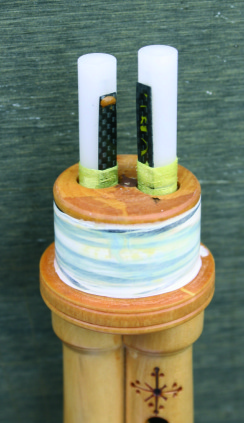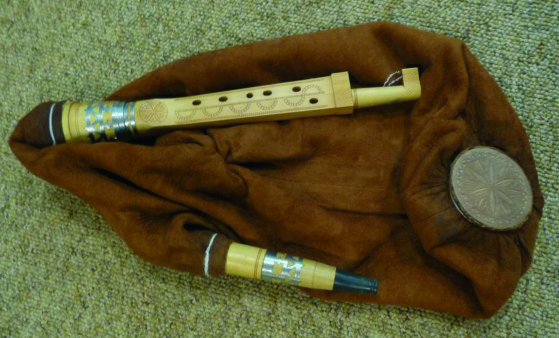The Bagpipe Society
Me and My Boha - a player's perspective

Much has been written about the story of this fascinating instrument and last year’s Blowout heard it being played by leading maker and practitioner, Robert Matta. This raised a lot of interest in an instrument which is still - surprisingly - relatively unknown in the UK and has featured only once before at the Blowout - by Yan Cozian in 2002 (how time flies!).
Looking for a single reeded pipe to add to my collection, a conversation with Yan at Chateau D’Ars led to my placing an order with Association Cozian Saintorens for their “Excellence” model. The clinchers were: reed stability, flexibility of key, ease of playing and, of course, that wonderful sound.
So, what is it and what can it do?
The modern boha is pitched in G (6 finger note). It is a double pipe with the chanter (pihet) and drone contained in one piece of wood The parallel drone (contra) can alternate between 2 notes by use of the right hand little finger - G unison and either D or E below the G, depending on the setup of the brunider, a short removable extension to the contra. With my boha, rotating the brunider opens a hole to sound E. Turn it 90 degrees and it plays D. With other makers, the E is obtained by completely removing the brunider, which is chained to the bottom of the pihet. The pihet is parallel bored, uses closed fingering and has a range of one octave plus F# leading note. There is also the option to have up to 3 alternative fingerholes, similar to those employed in the Swedish sackpipa, which can be plugged, giving B or Bb, E or Eb, top F or F#. This means that I can play easily in G major, G minor, E minor, C major, C minor, with certain limitations, given the range.

The reeds are carbon fibre, mounted on plexiglass bodies and very stable. Tuning the pihet and contra is critical and this is achieved by sliding the reed body further in or out, until the two are in harmony. There is a technique, which requires some patience, but fortunately this is not something that needs doing very often, due to the inherent stability of the reeds.
Playing the Boha
It is a joy to play: the pressure is surprisingly low and it is easy to leave 5 seconds or thereabouts between inflations. Finger spacing is comfortable. It takes a little while to adjust to different finger separations when moving from one key/mode to another, but this soon becomes instinctive. The spacing is a little tight when the Eb is in use and would present a challenge to someone with wide fingers. The playing pressure range is fairly narrow but not overly challenging - you soon know if you are applying too much or too little: the reeds will clap shut or the two notes will sound discordant. Like any instrument, you need to put in the time. Likewise with the closed fingering, if this is not a familiar system to you. The occasional lapse into half closed for example does affect the intonation but not excessively so, especially if you rapidly pass on to the next - correct - note!
The hardest aspect to master is the use of the contra: it takes time to train your little finger to operate independently of its neighbour and then you’ve got the decisions as to when to play one or other of the drone notes to best effect. Simple modulation is very effective and relatively easy to attain, at least on slow tunes, but using the contra to consistently beat double time for example, may be the work of years.
Here is why I get so much enjoyment from my boha: it has a plaintive wildness to its sound, set against a close pitched drone, which is dramatic and definitely head turning in a crowded room; it encourages you to play different tunes in styles you may not have considered before; the two tone drone arrangement gives a whole new dimension to explore; it is not tiring to play and finally, it is a compact little instrument which will not knock ornaments off shelves and will also pack down small.

Buy one!
I recommend equally both Association Cozian Saintorens http://www.yancozian.fr/ (click on fabrication) and Robert Matta http://www.cornemusesoccitanes.com/ Both make very high quality reliable instruments and, I believe, are the only professional makers of the modern boha as I have described.
Further resources
I recommend these publications, all by Yan Cozian and obtainable from his website:
-
The Boha (a tutor book which builds up technique from first principles and includes tuning tips and further repertoire);
-
Carnet de Bal en Gascogne (a repertoire of Gascogne dance tunes suitable for the boha. Includes a CD with each tune played twice);
-
Boha! Au coeur des Landes. L’incroyable histoire de la cornemuse landaise. (2 DVD set as reviewed in Chanter Winter 2014 page 32).
Editor’s note: Like Ian, I am a great fan of the Boha. When walking around Le Son Continu, there was always one sound of pipe that made me stop in my tracks and want to hear more of it – and that was the boha. I fell under its spell and decided to order one. However, typical of me, I went for the slightly perverse option! I bought a boha à cinq trous – a modern reproduction of the original bohas which only had 5 holes – rather than 6 - on the chanter. The range and flexibility is obviously not as great as on the modern, adapted versions (and needs a nifty bit of leg work, to cover the leading note hole which is on the side of the chanter!) and it also has cane reeds - so Ian’s statement about stability doesn’t necessarily ring true for me! However, it will play with an open, half-closed or fully closed fingering system. More information on Pascal Petizprez here http://bit.ly/Chanter3 See it being played, by the excellent musician, Adrien Villeneuve at http://bit.ly/Chanter4
- Data Processing Notice (GDPR)
@BagpipeSociety on X (formally known as Twitter)
TheBagpipeSociety on Instagram
 BagpipeSociety on Facebook
BagpipeSociety on Facebook
Something wrong or missing from this page? Let us know!
